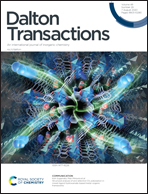Two new Cu-based borate catalysts with cubic supramolecular cages for efficient catalytic hydrogen evolution†
Abstract
Focusing on renewable energy, we are devoted to developping efficient, robust and low cost water reduction catalysts (WRCs). Two new Cu-based borate catalysts, namely H2Na2K2[(μ4-O)Cu4@B20O32(OH)8]·21H2O (1) and H2Rb1.6K2.4[(μ4-O)Cu4@B20O32 (OH)8]·15H2O (2), with cubic supramolecular cages were synthesized under a hydrothermal condition. Moreover, new copper complexes were applied as water reduction catalysts (WRCs) in the presence of [Ir(ppy)2(dtbbpy)][PF6] as photosensitizer and triethanolamine (TEOA) as the sacrificial electron donor. Nevertheless, the main active place is attributed to the centre of Borates [(μ4-O)Cu4@B20O32(OH)8], and the atomic radius of the counter cation would be the critical factor of the photocatalytic activity. Increasing the atomic radius from the Na atom to the Rb atom, causes the photocatalytic activity to decrease efficiently. The experimental results match well with the density functional theory (DFT) conclusion. It is noteworthy to mention that our research not only enriches the Cu-based borate chemistry, but also investigates the photocatalytic activity of Cu-based borates. This would guide us through the borate synthesis and to develop their applications toward energy and the environment.



 Please wait while we load your content...
Please wait while we load your content...